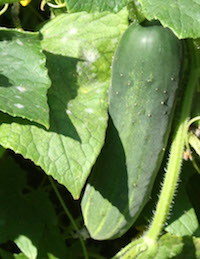Summer is a great time for fresh local produce, but Georgia summers can present many challenges for gardeners trying to keep crops healthy and alive. This is especially true for tomatoes and cucurbits.
Cucurbits are from the family Cucurbitaceae that includes squash, pumpkin, cucumber, gourd, watermelon and cantaloupe. Squash and cucumbers especially can be challenging crops to grow due to pests and diseases. Wet weather compounds the problems.
Some of the more common diseases that strike are downy and powdery mildew, anthracnose, and cucurbit yellow vine disease.
Downy mildew
The downy mildew pathogen survives the winters mainly in southern frost-free regions. The disease spores reach Georgia from late May into June. This year the arrival appears to be delayed, but the recent wet weather disease gives it the potential to be severe.
Symptoms start as bright yellow angular spots on the leaf surface. Leaves later turn brown, often starting from the edges, causing a progressive defoliation from older to younger leaves.
Manage the disease with a combination of cultural practices, resistance, and, if desired, targeted sprays. Certain cultivars have some resistance. Keeping plants healthy with balanced nutrition and in an open sunny location will help lessen the effects of this and other diseases.
Powdery mildew
Powdery mildew does not survive winters in the field but greenhouses can provide a potential early source of spores. Powdery mildew has been prevalent this year and the disease has the potential to defoliate plants. This is one of the easiest of diseases to diagnose since it is the only foliar disease where the fungus grows on the surface.
Because of this surface growth there are more alternative and organic control products that may potentially prevent powdery mildew. There are also more cultivars available with powdery mildew resistance.
Anthracnose
Anthracnose is mainly a concern on cucumbers and melons. The symptoms include leaf spots, defoliation and sometimes fruit lesions. The diseases survive in the infected debris, so rotation and the destruction of plant debris at the end of the season are important preventative measures. Wet weather is a major contributing factor. Trellising and/or the use of high tunnels, especially with cucumbers, can help reduce infections.
Cucurbit yellow vine
Cucurbit yellow vine disease is a new bacterial disease in Georgia that mainly affects squash and pumpkins. The disease is spread by squash bugs and results in the sudden yellowing, wilting and collapse of plants. The symptoms may be confused with stem borer damage. Squash bug management is the best way to prevent this disease. Losses are substantial where the disease occurs.
University of Georgia Cooperative Extension plant pathologists are mapping cucurbit yellow vine disease in Georgia. If you think you have this disease in your garden, contact Elizabeth Little at elittle@uga.edu or (706) 542-4774.
For more information on growing cucumbers in the home garden, see the UGA Extension publication at www.caes.uga.edu/publication.







